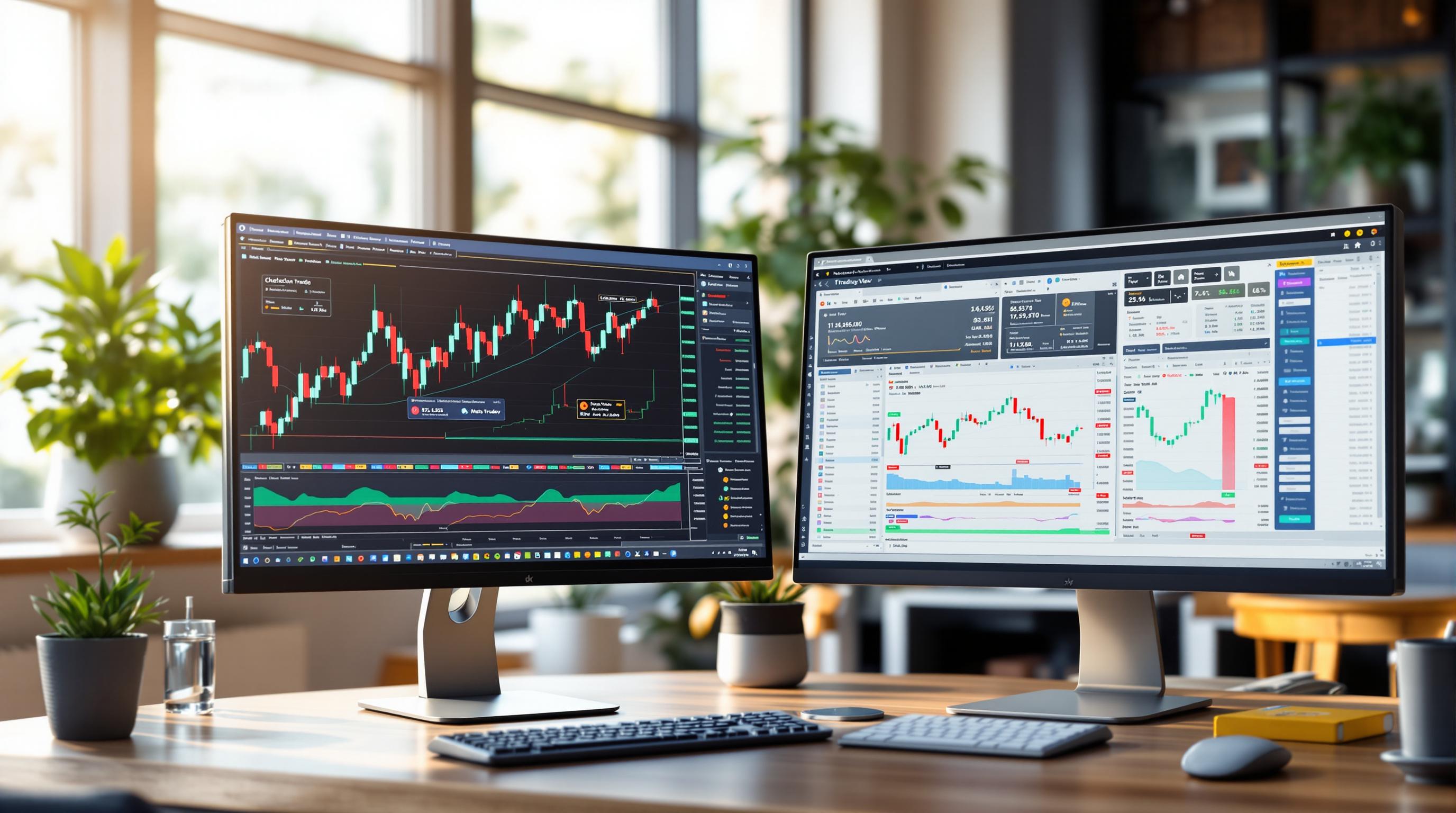Risk management tools in 2025 are smarter, faster, and more accessible than ever. They combine real-time analytics, AI-driven predictions, and automated compliance to help investors reduce risks, stay compliant, and make informed decisions. Here's what you need to know:
-
Key Features:
- Real-time analytics for instant market insights
- AI predictions for better forecasting
- Automated compliance to meet regulatory standards
- Seamless integration with existing systems
-
Top Platforms:
- TradingView: Advanced charting and risk analysis
- Trade Ideas: AI-powered market scanning
- Stock Rover: Portfolio risk screening
- TradeStation: Compliance-focused monitoring
- Why It Matters: These tools simplify complex markets, offering options flow tracking, seasonality analysis, and more. They’re designed for both individual investors and institutions, making risk management easier and more effective.
Quick Comparison:
| Platform | Key Features | Best For |
|---|---|---|
| TradingView | Real-time monitoring, charting | Technical analysis |
| Trade Ideas | AI-driven insights, alerts | Market scanning |
| Stock Rover | Portfolio tracking, compliance | Risk screening |
| TradeStation | Compliance tools, integrations | Regulatory monitoring |
These tools are essential for navigating today’s markets. Choose the one that fits your needs, whether it's advanced analytics, AI insights, or robust compliance features.
+5 Best Risk Management Software Sytems 2024 [Full Demo]
Core Functions of Risk Management Tools
Risk management tools have evolved to address the growing complexities of today's markets. These platforms provide advanced features that help investors make informed decisions while staying compliant with regulations.
Data Analysis and Reporting
Modern risk management platforms leverage AI and machine learning to analyze massive amounts of market data in real time. For example, Stock Rover offers extensive portfolio tracking and supports integration with over 900 brokers.
Trade Ideas' AI-powered platform processes multiple data streams, including:
- Real-time market indicators
- Volatility metrics
- Institutional trading activity
- Sentiment analysis
- Seasonal trends
These insights allow investors to respond swiftly to changing market dynamics. Additionally, many platforms now incorporate tools that simplify and automate risk management workflows.
Workflow Tools and Settings
Platforms like Composer enable no-code automation, allowing users to create custom risk management strategies effortlessly. TradingView enhances risk modeling with flexible displays tailored to various investment approaches. Key features include:
| Feature Category | Capabilities |
|---|---|
| Risk Modeling | - Adjustable risk settings - Stress testing - Scenario analysis |
| Automation | - Alert systems - Trade execution - Position sizing |
| Customization | - Personalized dashboards - Custom indicators - Risk thresholds |
These workflow tools improve efficiency, while regulatory tools ensure compliance remains a priority.
Regulatory Tools and System Links
Trade Station simplifies regulatory monitoring by automating audit trails and generating compliance reports when needed. Its system is designed to integrate seamlessly with:
- Customer Relationship Management (CRM) systems
- Enterprise Resource Planning (ERP) software
- Market data providers
- Trading platforms
- Risk reporting systems
These integrations help ensure that risk management tools function smoothly within existing business systems. Regular updates keep investors aligned with evolving regulatory standards, reducing the need for manual adjustments.
Leading Risk Management Tools for 2025
Modern platforms are stepping up with AI-powered features that tackle operational risks and simplify compliance. By leveraging advanced analytics and dynamic risk assessments, these tools are designed to meet the demands of today’s fast-paced financial environment.
Main Platform Features
TradingView offers a suite of technical analysis tools aimed at managing portfolio volatility:
| Feature Category | Capabilities |
|---|---|
| Market Analysis | - Real-time monitoring - Advanced charting tools - Customizable indicators |
| Risk Assessment | - Portfolio testing - Volatility tracking - Correlation analysis |
| Integration | - Multi-broker connectivity - API support - Compatibility with external tools |
Stock Rover builds on these functionalities by focusing on portfolio risk screening and ensuring compliance through its specialized tools.
Key Benefits by Platform
Each platform brings unique strengths to operational risk management:
| Platform | Key Benefits |
|---|---|
| Trade Ideas | - AI-powered market scanning - Risk notifications - Flow tracking tools |
| Stock Rover | - Detailed portfolio risk analysis - Seamless broker integration |
| TradeStation | - Comprehensive risk monitoring - Compliance-focused features |
These tools also offer mobile-friendly options, allowing users to monitor and address risks on the go. With features designed to identify issues early, they help protect portfolio performance while aligning with the shifting demands of the financial landscape. This makes them strong contenders for anyone looking to refine their risk management strategy.
sbb-itb-2e26d5a
Selecting a Risk Management Tool
Choosing the right risk management tool means aligning it with your organization's specific needs and operations. Here's how to approach it step by step.
Business Requirements
Start by identifying your organization's key needs. Think about the size and complexity of your operations, such as how many transactions you handle daily. Make sure the tool complies with any necessary regulations and fits seamlessly with your existing systems. Once you've nailed down these requirements, you can move on to evaluating the tool's features.
Features and Ease of Use
Prioritize tools that are easy to use and improve day-to-day efficiency. Look for features like an intuitive user interface, customizable dashboards, mobile accessibility, and real-time alerts. Strong data management capabilities are also crucial - this includes access to historical data, options to create custom reports, and simple data export. Make sure the platform can grow with your organization over time. Once you're confident about the features, shift your focus to costs and support.
Price and Support
Don’t just look at the software's upfront cost - consider the total cost of ownership. This includes expenses for training, technical support, and ongoing maintenance. Choose a provider that offers thorough training and responsive customer support to help you get up and running quickly. For more in-depth reviews and comparisons, check out Best Investing Tools Directory (https://bestinvestingtools.com). This resource can help you find options that meet your specific needs.
Tool Comparison Chart
Here's a quick look at the key features of four popular platforms for 2025. This table highlights their main analytic tools and integration options, giving you a clear picture of what each offers.
Feature Comparison
| Feature Category | TradingView Pro | Trade Ideas AI | Market Chameleon | SpotGamma |
|---|---|---|---|---|
| Core Analytics | Advanced charting tools | AI-driven analysis | Options flow tracking | Options flow tracking |
| Integration | Works with various brokers and platforms | Links to brokers | Syncs with trading platforms | Connects to financial systems |
TradingView Pro stands out with its advanced charting tools, making it a great choice for in-depth technical analysis. Trade Ideas AI brings AI-driven insights to the table, while Market Chameleon and SpotGamma both specialize in tracking options flow. All four platforms offer strong integration capabilities, making it easy to fit them into your financial workflows.
To pick the right tool, think about your specific needs - whether it's detailed charting, AI insights, or options flow tracking - and how well the platform fits with your current systems.
Summary
By 2025, risk management tools have become a cornerstone for successful investing, combining real-time analytics, AI-driven insights, and automated compliance features. These platforms have come a long way, now offering a mix of advanced data analysis, workflow automation, and regulatory tools.
Today's tools use cutting-edge analytics and automation to reshape risk assessment - offering everything from detailed charting to automated monitoring. These advancements play a key role in determining which platform best fits your needs.
When selecting a platform, ensure it aligns with your investment strategy and operational requirements. Evaluate its technical capabilities and confirm the availability of strong support. For detailed reviews on portfolio tracking, options analysis, and risk metrics, check out Best Investing Tools Directory.
The top platforms strike a balance between powerful analytics and easy-to-use interfaces, making it simpler to incorporate risk management into your daily workflow. As markets shift, keeping up with the latest tools will help you stay competitive in your investment approach. This blend of features and support defines the evolving risk management landscape in 2025.
FAQs
How do AI-powered predictions improve risk management tools in 2025?
AI-powered predictions significantly enhance the effectiveness of risk management tools by providing real-time analysis and data-driven insights. These tools can process vast amounts of data quickly, identify potential risks, and forecast trends, helping investors make more informed decisions.
In 2025, AI-driven tools are also more adept at recognizing patterns and anomalies, enabling early detection of issues like market volatility or operational inefficiencies. This allows both individual and institutional investors to proactively mitigate risks and optimize their strategies with greater confidence.
What should I look for in a risk management tool to ensure it works well with my current systems?
When selecting a risk management tool, it's important to evaluate how easily it integrates with your existing systems and workflows. Look for tools that support the software and platforms you already use to avoid compatibility issues and streamline operations.
Additionally, consider features like customization options, data import/export capabilities, and real-time updates to ensure the tool meets your specific needs. Exploring reputable resources, such as directories of investing tools, can help you compare options and make an informed decision.
How do automated compliance features in risk management tools support investors in meeting regulatory requirements?
Automated compliance features in risk management tools help investors stay aligned with regulatory standards by streamlining processes and reducing human error. These tools can monitor transactions, flag potential violations, and generate reports to ensure transparency and accountability.
By automating tasks like data validation and regulatory reporting, investors can save time and focus on strategic decision-making. Additionally, these features often include updates for evolving regulations, ensuring that users remain compliant with the latest legal requirements.



